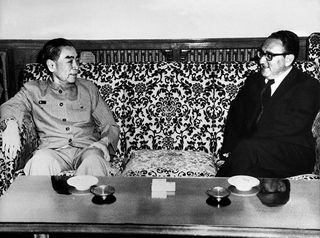
Jessica T. Mathews reviews Henry Kissinger's World Order and Bret Stephens's America in Retreat: The New Isolationism and the Coming Social Disorder, in the NYRB (photo AFP/Getty Images):
Since the US took on international leadership at the close of World War II, the debate over interests and values has become entangled with others that are importantly, if subtly, different. One is whether the US should usually choose to act alone, or try instead to achieve the greater legitimacy—and restrictions—that accompany multilateral action. Unilateralist views reached a new high in the George W. Bush administration. Those of John Bolton, briefly ambassador to the UN, were characteristic:
It’s a big mistake for us to grant any validity to international law, even when it may seem in our short-term interest to do so—because, over the long term, the goal of those who think that international law really means anything are those who want to constrict the United States.
Setting aside the matter of legitimacy, even a cursory look at the vast body of international law developed over the past seventy-five years—from trade and banking to human rights and arms control—reveals how deeply American interests have been served by it.
Closely related to that debate is the argument over American exceptionalism. American contributions to international security, global economic growth, freedom, and human well-being have been so self-evidently unique and have been so clearly directed to others’ benefit that Americans have long believed that the US amounts to a different kind of country. Where others push their national interests, the US tries to advance universal principles.
At its extreme, this reasoning holds that the US should not be bound by international rules, even those it has itself developed, but should occupy a position above the rest. In this view, it is in the world’s interest, not merely the American interest, for the US to do so. A month after the attacks of September 11, 2001, Max Boot of The Wall Street Journal called on America to unambiguously “embrace its imperial role.” “The organizing principle of empire,” according to the like-minded Stephen Rosen in The National Interest, “rests on the existence of an overarching power that creates and enforces the principle of hierarchy, but is not itself bound by such rules.”
Weaving together these and similar themes in America in Retreat, Stephens argues that the US must now shoulder the responsibility for establishing and maintaining a global Pax Americana. All the alternatives, including traditional balance of power and collective security, have been tried and failed. Americans “mainly want to be left alone,” but instead have to “sharply increase military spending to upwards of 5 percent of GDP” (i.e., by a third or more from today’s 3.8 percent); “once again start deploying forces globally in large numbers”; and be prepared to undertake “short, mission-specific, punitive police actions” around the globe.
The basis for such a drastic shift is his belief that international security is skidding downhill. The evidence suggests otherwise.
More here.
Geoff Dyer at The New Statesman:
